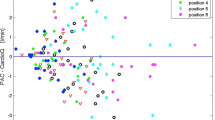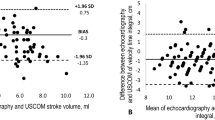Abstract
This study was performed to evaluate the hemodynamic status of children admitted to the intensive care unit, using suprasternal and transesophageal Doppler ultrasound, and to establish a suitable noninvasive technique to monitor trends in cardiac output in critically ill children. Twenty children were studied over a period of 6 months. The median age was 32.5 months and weight 14.5 kg. Minute distance (MD), which is a linear cardiac output parameter, was assessed. Seven simultaneous pairs of measurements of MD were made using transesophageal Doppler (TED) and suprasternal Doppler (SSD) by the same operator. Following a fluid challenge, seven repeat pairs of measurements were made. The mean percentage changes for MD by TED and SSD were 21.84 (SD 9.97) and 5.75 (SD 7.32). The average coefficients of variation for measurements of MD by TED and SSD were 2.34% and 15.98%, respectively. The mean difference in percentage change between MD, measured by TED and SSD, was 27.59 with a 95% confidence interval and wide limits of agreement. The repeatability of TED measurements was good, but the measurements by SSD were wide and erratic with poor reproducibility. Our study shows that TED is easy to use, reliable, and very useful for monitoring hemodynamic changes in critically ill children.
Similar content being viewed by others
Author information
Authors and Affiliations
Rights and permissions
About this article
Cite this article
Mohan, U., Britto, J., Habibi, P. et al. Noninvasive Measurement of Cardiac Output in Critically Ill Children. Pediatr Cardiol 23, 58–61 (2002). https://doi.org/10.1007/s00246-001-0014-2
Published:
Issue Date:
DOI: https://doi.org/10.1007/s00246-001-0014-2




